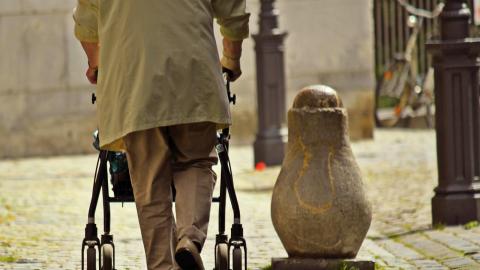Accessible Seating for Persons Who Use Walkers
0 comments
2753 views

Recently, I received the following question:
"Our church has a dozen people who use wheeled walkers to get around. At present, when the ushers seat them, the walkers are taken away and put in the very back of the church, out of the way. I don't like this arrangement, because any assistive devices in use become an extension of that person’s body, and thus should not be removed from them. Also, without the walkers, which enable them to walk and stand up on their own, they become disabled. If there were to be an emergency that would require them to leave the sanctuary, they would not be able to move out. Getting the right walker to the right person in case of an emergency would be time consuming and could be confusing in an already confusing situation. We do not have room to keep them in the aisles, plus that would be a hazard too. We could remove one pew so that all the people who use walkers can sit in the same pew and keep the walkers in front of them, but then they could not sit with their families and it also marks them. Given the fact that some like to sit near the front and others by the back, this does not seem to be the best idea. How have other churches solved this?"
I posted the question on a listserv of leaders involved in disability ministry and received a number of helpful responses. Thanks to a friend who compiled the comments into the form they take below: Charlotte Hawkins Shepard, Ph.D., Retired Consultant, Accessibility & Inclusion of Persons with Disabilities, Episcopal Church in the United States of America (ECUSA),
RESPONSES/STRATEGIES
I think this is another reason that every church with pews should have multiple pew cuts in a variety of spots in the sanctuaries - front, middle, and back. If limited seating is an issue the cuts can contain chairs with armrests (also needed by some folks with mobility challenges, especially after hip surgery) that can be simply removed and stacked by the usher if the cut is needed. (f chairs are used rather than pews it is easy enough to replace or move several as needed, and there could be a few gaps to start with.
I don't think the walker should be any further away than against the aisle wall at the end of the pew or row where the person is seated. I agree that the back of the sanctuary is not a safe place. Most walkers, including the four wheeled type, can be folded to take up less space unless the baskets are full! And there are some people who prefer to sit on the walker seat because it is easier to get up from, so the pew or chair cuts would allow this possibility, too.
We were at Chicago Temple First UMC recently - a church that did a great job with their remodel and had 5 different pew cut areas - in case anyone wants to see how this looks. The sanctuary is beautiful.
Lynn Swedberg, M.S., OTR/L
Disability Consultant
Disability Ministries Committee of theUnited Methodist Church
_____________________________________________________________________
I know of one church community that was quite concerned about numerous people with walkers moving slowly toward the communion rail, causing a kind of bottleneck or impasse in the aisles. It was considering a remedy for that consisting of pew cut placement in one area only (I think it was the front). I was very much against that idea for several reasons, but primarily because such a strategy would again relegate people with physical disabilities to one place, denying them the seating choice that people without disabilities have. It seemed to me that one or two additional communion stations would be a far better solution.
Charlotte Shepard, Ph.D.
Retired Consultant, Accessibility & Inclusion of Persons with Disabilities
Episcopal Church in the United States of America (ECUSA)
_____________________________________________________________________
I totally agree that taking the walkers away from their users is not appropriate, polite or safe. Neither is corralling all of them on one or two pews. The best solution I can imagine is to do some pew cutouts to a number of pews in different parts of the sanctuary, probably starting where these present members like to sit. That’s more work that just removing one or two full pews, but it allows flexibility of choice for these people with walkers and anyone who may use a wheelchair or scooter.
Carolyn R. Thompson, M.Div.
Member, Reference Committee
World Council of Churches: Ecumenical Disability Advocates Network
Disability Concerns, Church Admin & Finance
Disability Concerns, Church Admin & Finance
Disability Concerns, Training and Education
Disability Concerns
Connect to The Network and add your own question, blog, resource, or job.
Add Your Post
Let's Discuss
We love your comments! Thank you for helping us uphold the Community Guidelines to make this an encouraging and respectful community for everyone.